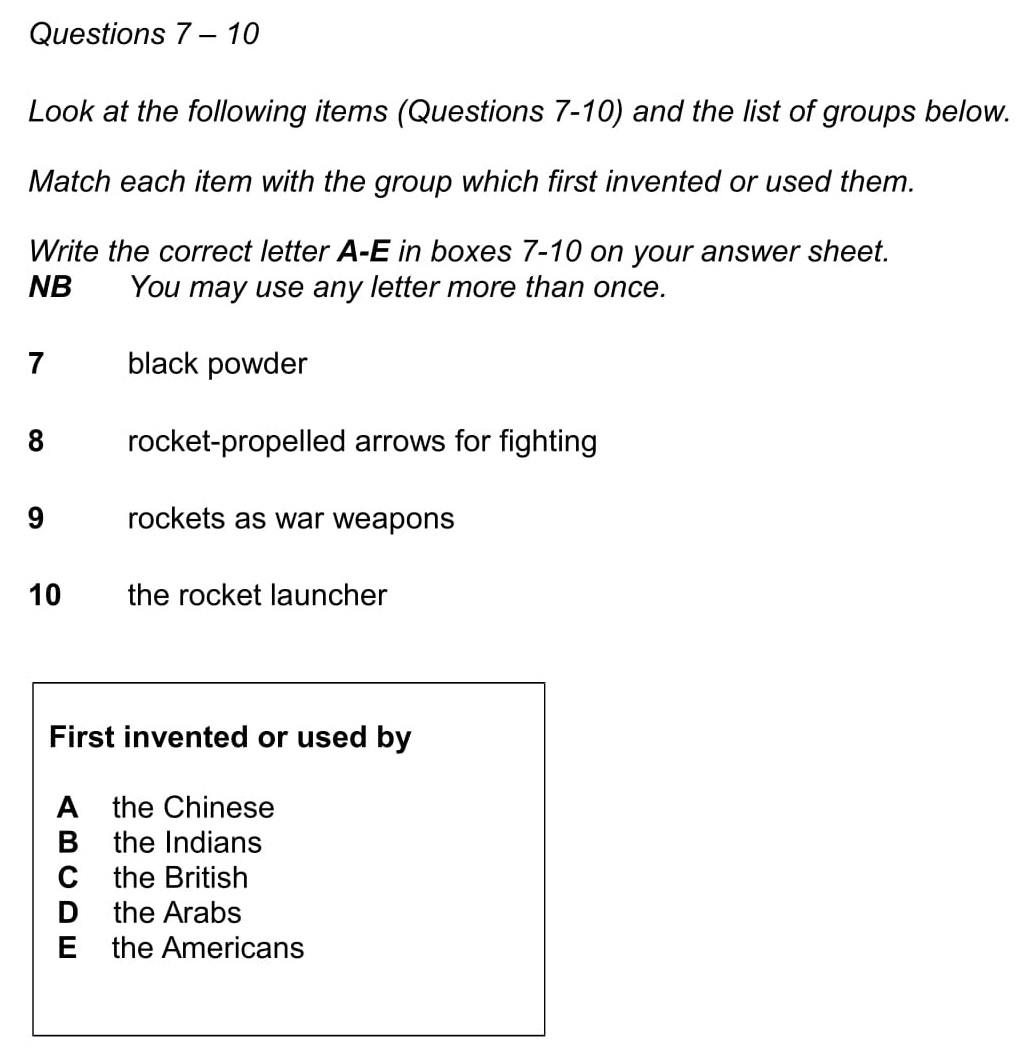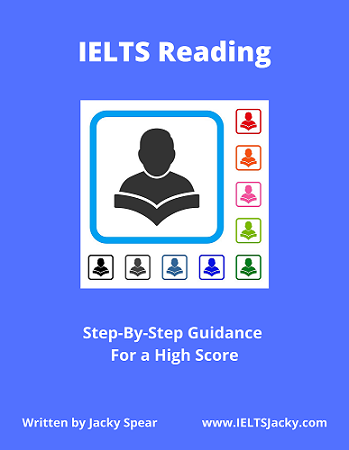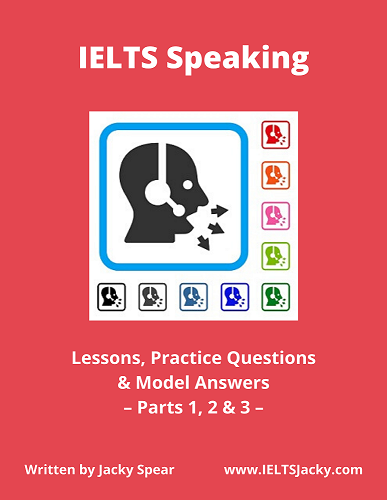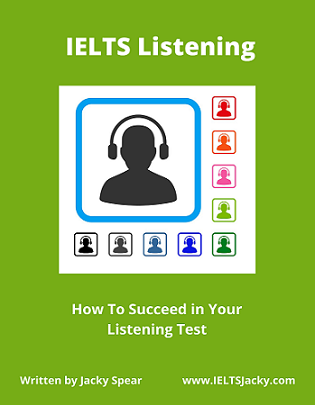IELTS Reading Tests
How To Answer Name Matching Questions
Completing
practice IELTS reading tests is an important part of your exam preparation but
you also need to understand how to answer all the different type of questions.
On this page, I’m going to show you step-by-step how to answer a Name Matching question using two different strategies.
You’ll find lots more tips and information, including more practice IELTS reading tests, on the main page about Name Matching questions. Click the link to visit the page.
It includes:
- Explanation of the question type
- Skills needed
- Key tips
- Proven strategy
- Examples & model answers
Learn From Real IELTS Reading Tests
Here are a few key things from the main Name Matching page that you need to know before we start work on the text we'll be working on today.
- For this type of question, you have to match a list of names to a list of statements using the information in the text to make the correct matches.
- The statements will not appear in the same order in the text as they are listed in the instructions. Neither will the names appear in the same order that they are listed.
- Usually, there will be different numbers of statements and names. You may not need all the names and you may be allowed to use a specific name more than once. Refer to the instructions for guidance.
- The statements will generally paraphrase information in the text and synonyms will often be used.
Below are the questions and text for this IELTS reading test. If
you want to use it as a practice test, have a go at answering it yourself
before reading my instructions.
As with the other sample IELTS reading tests on the website, I’ve added a PDF of the questions and text that you can download to make it easier to work on. The answers are at the bottom of this page.
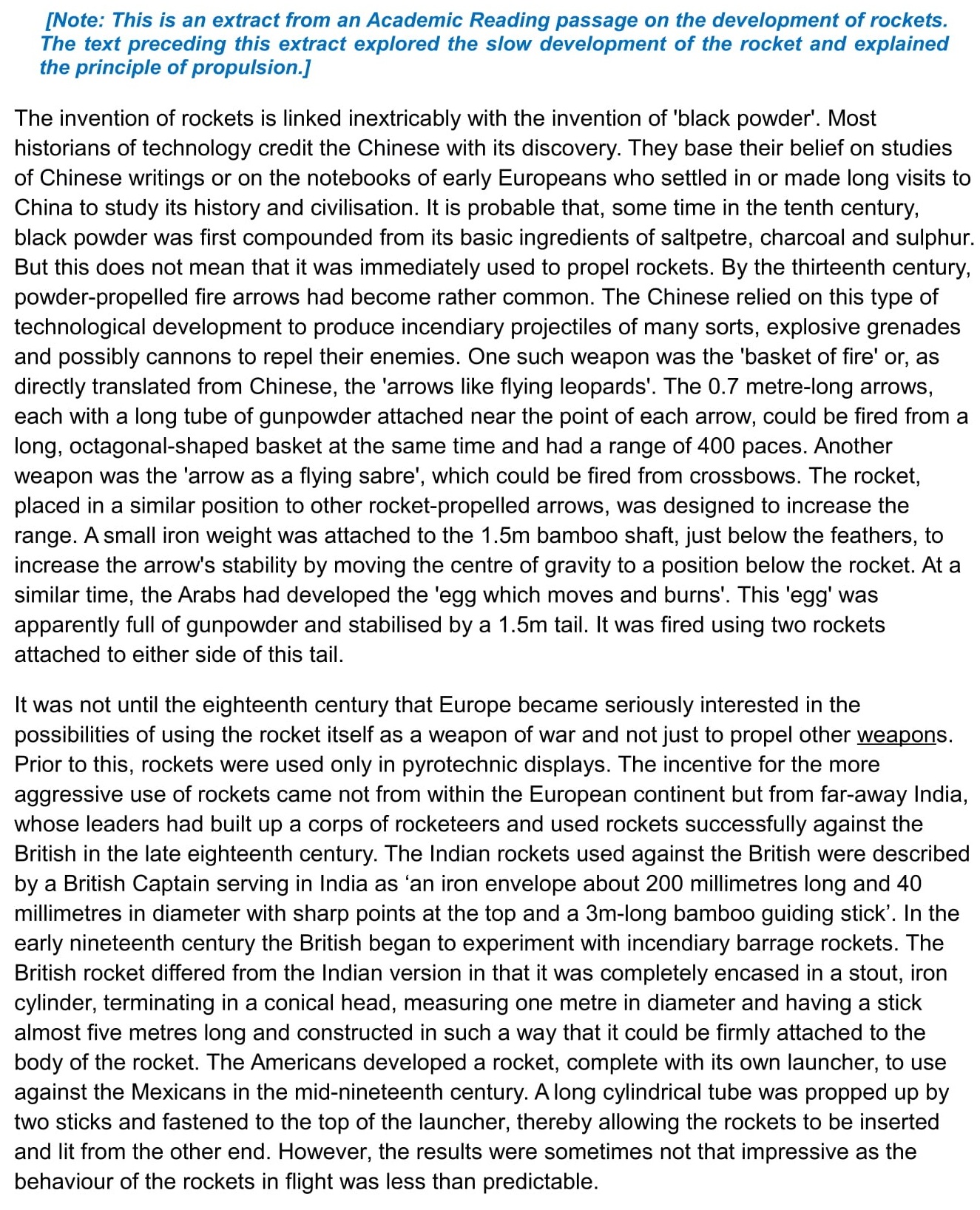
In many
questions, you’ll get a list of names of individual people whereas in this
example, the names are nationalities.
Download PDF of this IELTS Reading tests' text & statements.
Step-By-Step Instructions
Strategy 1
1) Read the instructions carefully to make sure that you know what type of question it is and what you have to do.
2) Read the statements
and try to understand what they mean. Doing
this will also give you a good idea of what the text is about.
3) Scan the text for the names in the list and underline them. Do this before reading the text. You'll find them extra quickly by focusing on the capital letter at the start of each name. Some names will appear more than once.
It’s helpful to use a different coloured pen or highlighter for each name as you can see here.
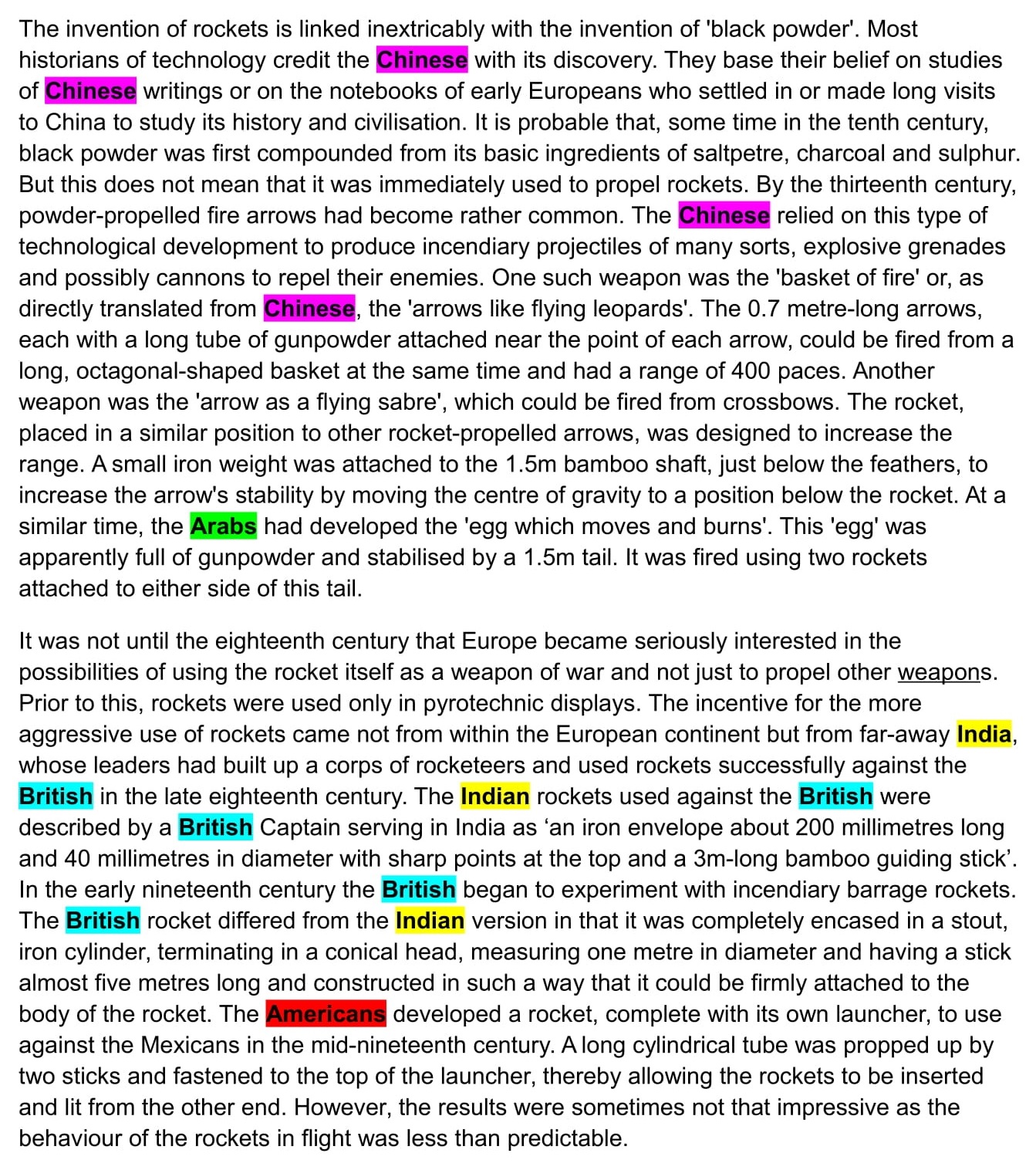
4) Most often in this type of question, the quickest method of matching the names and the statements is to work through the names, starting with the one that occurs the least number of times in the text.
However, in this case, there are some good key words in the statements so we’ll work on these instead and look at the other strategy later. You’ll still find is helpful to have highlighted the names first.
5) Start with the first statement. (You don't have to match the statements in order. Do the ones with the strongest key words first. In this question, all the statements have good key words.)
7 black powder
Scan the text for the key words ‘black’ and ‘powder’, being mindful that synonyms might be used.

They’re easy to spot as they appear together at the beginning of the text.
Read the sentence in detail to see if the information matches the statement. It does, so we’ve found our first answer.
Answer: 7 A (the Chinese)
6) Statement 8 also has a strong key word.
8 rocket-propelled arrows for fighting
Scan the text for ‘arrows’.

It appears a short way further on in the same paragraph, although, do remember that the answers won’t necessarily come in order in the text.
Now that you know the location of the information, read in detail to check that it’s a match to the statement. Note the paraphrasing that has been used:
Statement Text
rocket-propelled – power-propelled
fighting – repel their enemies
The information matches and we’ve found the second answer.
Answer: 8 A (the Chinese)
7) Statement 9 is slightly more general in meaning but statement 10 is again about something very specific. It will probably be easier to match so we’ll do this one next.
9 rockets as war weapons
10 the rocket launcher
The word rocket occurs throughout the text so just scan for ‘launcher’ or a synonym of it.
It’s not difficult to find.

Now read the sentence in detail to check that the information
matches. It does so we’ve found another answer.
Answer: 10 E (the Americans)
8) This leaves us with just one statement to match
9 rockets as war weapons
The key words to scan for are ‘weapons’ and ‘war’.
‘Weapons’ appears twice in the first paragraph. However, when we skim read the text around this key word, we find that it refers to arrows that are propelled by rockets that are attached to them rather than talking about actual rockets. This isn’t really a close enough match of information.
‘War’ is not present at all in this section of text.
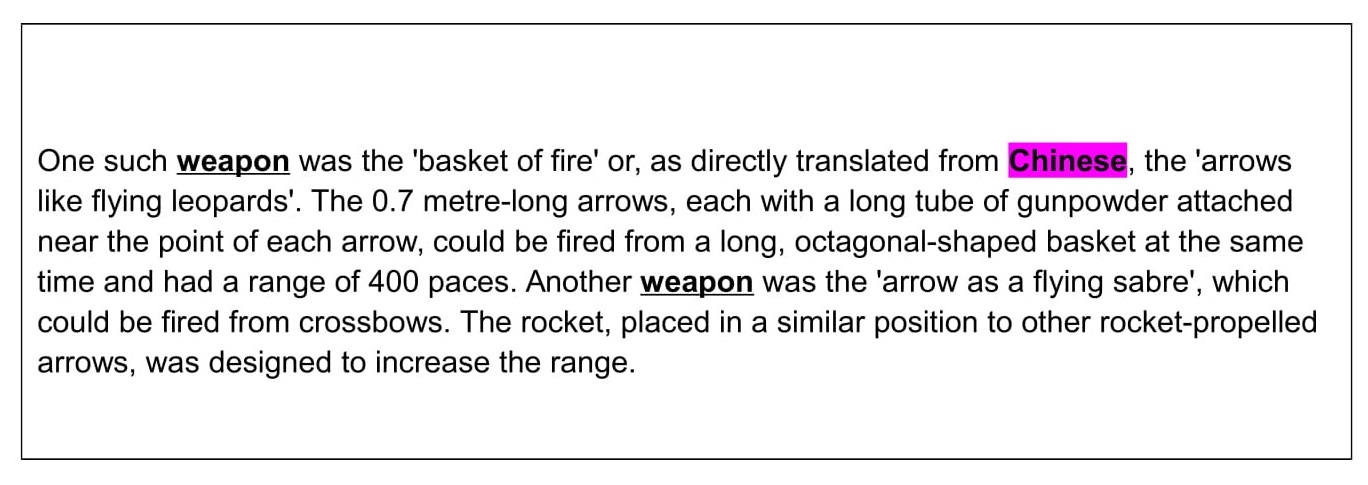
On scanning the second paragraph, we find ‘weapons’ another two
times and also ‘war’. We can immediately see from our highlighted names in the
following sentences that the answer is either going to be ‘the Indians’ or ‘the
British’.
Having identified the location of the information in the text, look at statement 9 again to remind yourself what information you need to match, then read around the key word in detail to understand the full meaning of what is being said. You can expect paraphrasing to have been used.
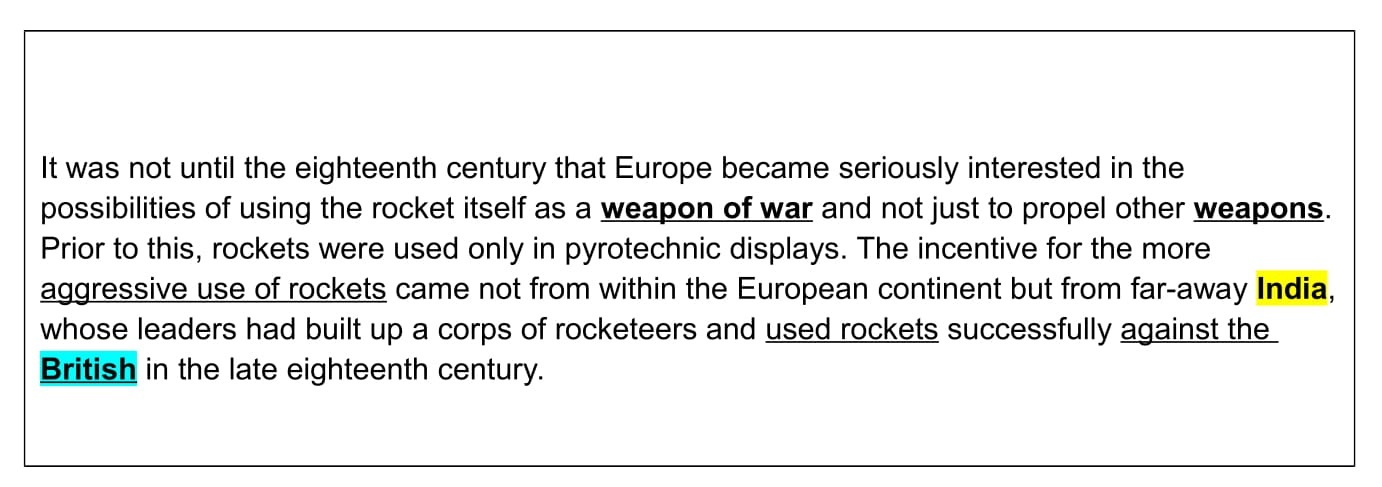
There are two key phrases here that give us the information we need.
- The incentive for the more aggressive use of rockets came not from within the European continent but from far-away India…
- used rockets successfully against the British
Both
clearly refer to rockets being used as war weapons.
Answer: 9 B (the Indians)
We’ve now completed the whole question.
Strategy 2
We'll now look at the second strategy for answering Name Matching question in IELTS reading tests.
# 1, 2 & 3 The first three steps are the same as for Strategy 1.
# 4 In this strategy we’re going to work with the names rather than key words in the statements. This is often the quickest method of answering name matching questions.
The easiest names to match to a statement will be those that appear only once in the text. Do these first. This will also quickly eliminate the matching statements from further consideration thus narrowing the options for the rest of the names.
# 5 The first name to appear just once in our text is the ‘Arabs’.
Read around the name to discover what aspect of rockets the Arabs developed.

Return
to the statements to see if there’s a match of information.
There's no match so we can eliminate ‘the Arabs’ from further consideration.
# 6 The other name to appear only once is the ‘Americans’.
Read around the name to discover what the Americans invented.

Again, return to the
statements to see if there’s a match of information. This time there is.
10 the rocket launcher
Answer: 10 E (the Americans)
Cross through statement 10 in the list and move on to another name.
# 7 ‘Indians’ appears only twice in the text so it’s the best name to choose next. As before, read around the name for the information related to it.

The second sentence that it’s mentioned in is actually about the British rocket so we can ignore this and focus on the first sentence.
This sentence gives a detailed description of the Indian rocket. Try to picture what it’s describing then check the remaining statements to see if there's a match.
7 black powder
8 rocket-propelled arrows for fighting
9 rockets as war weapons
It’s clearly not 7 but both 8 and 9 are possible matches.
Here’s my reasoning:
- ‘The Indian rockets used against the British...’ does indeed refer to rockets being used as war weapons.
- The rocket described – ‘an iron envelope about 200 millimetres long and 40 millimetres in diameter with sharp points at the top and a 3m-long bamboo guiding stick’ – sounds like an arrow type weapon.
However, there’s not quite enough information here to decide which, if either, are correct.
In this situation, make a pencil note of possible answers and move on to another name. Come back to this one when you’ve eliminated more of the statements and there are fewer to choose from.
# 8 ‘The British’ occurs more often in the text than the other remaining name, ‘the Chinese’, but it’s a good next choice because all five appearances occur in a relatively short section of the text.

Start
by skim reading this block of text to get the general meaning and find the
location of information that could potentially match one of the statements.
There’s only one sentence containing information about a British rocket; the last one.

Look
at the remaining statements again, then read the sentence in detail to see if
there’s a clear match of information.
There isn’t so ‘the British’ is not one of the answers.
# 9 Finally we come to ‘the Chinese’. Almost the whole of the first paragraph is about their inventions.
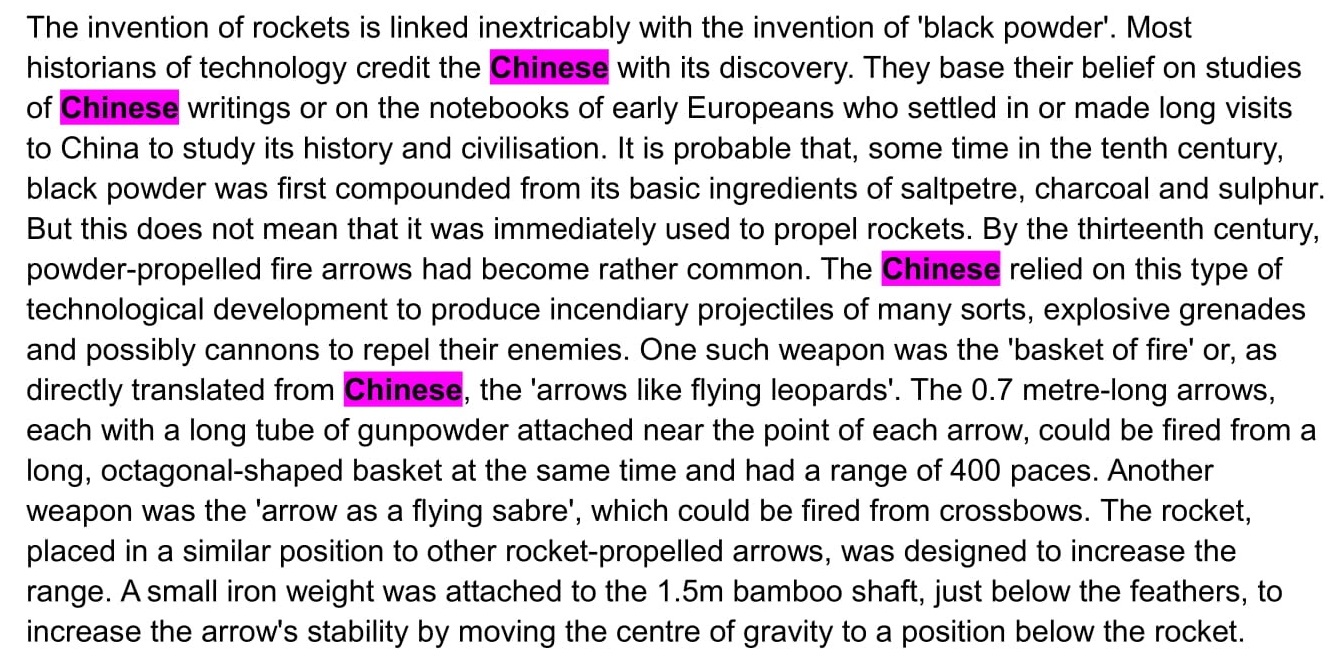
As this is
such a large block of text, we’re going to change tactics and scan it for
keywords in the remaining statements.
7 black powder
8 rocket-propelled arrows for fighting
9 rockets as war weapons
# 10 Start with the first statement.
7 black powder
Scan the text for the key word ‘black powder’, being mindful that a synonym such as ‘gunpowder’ might be used.

It
appears right at the beginning of the text and we have a clear match of information.
Answer: 7 A (the Chinese)
# 11 Statement 8 also has a strong key word.
8 rocket-propelled arrows for fighting
Scan the text for ‘arrows’.

It appears a short way further on in the same paragraph.
Now that you know the location of the information, read in detail to check that it’s a match to the statement. Note the paraphrasing that has been used:
Statement Text
rocket-propelled – power-propelled
fighting – repel their enemies
The
information matches and we’ve found another answer.
Answer: 8 A (the Chinese)
# 12 There's now just one statement left to match.
9 rockets as war weapons
We’ve already noted that ‘the Indians’ is a potential match so we can now confirm this to be the correct answer.
Answer: 9 B (the Indians)
Our Name Matching question is now complete.
I hope you’ve found these two strategies helpful. There’s never one right way to answer specific types of questions in IELTS reading tests and you probably noticed in Strategy 2, that we actually reverted to the Strategy 1 technique towards the end as it fitted the task better.
Try both these methods and see which works best for you. It may largely depend on the individual question and whether or not the statements contain strong key words.
Don’t forget to check out the main Name Matching Questions page for more tips and information as well as more practice IELTS reading tests.
Answers
7
A
8 A
9 B
10 E
Like this page?
Find More IELTS Reading Tests
on These Pages
Step-by-step strategies for answering the 12 different types of IELTS Reading questions with examples and practice tests.
You'll Also Find IELTS Reading Tests Here:
IELTS Reading Sample – True, False, Not Given sample test
IELTS Reading Samples – Matching Headings & Diagram Labelling sample tests
IELTS Reading Practice Test – More examples of Matching Headings and a Diagram Labelling questions & how to answer them
IELTS Reading Exercise – Yes, No, Not Given sample test
More Reading Test Practice – Matching Information sample test
IELTS Reading Paper – Multiple Choice sample test
Reading Tests For IELTS – Summary Completion test
